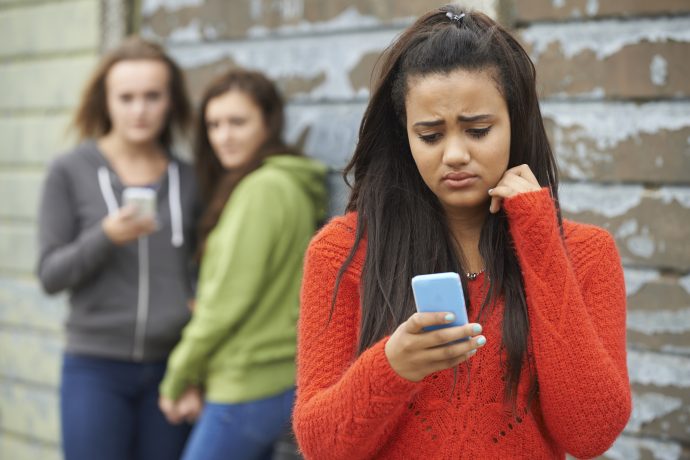Imagine walking down the hallway of a middle school and seeing the words “ugly loser” written on the locker of a sixth grade student, the bold letters overshadowing a student’s personal space at school. Some peers point and laugh as they pass by; others look away with expressions that can’t be read.
When someone notifies school staff, they react quickly and remove the mean words, but the light shadows of the black marker remain smudged on the door, a daily reminder of someone’s intent to publicly humiliate another student.
Now imagine that same message posted within an anonymous app or sent in a group text message. It’s not only those walking in the hallway that see the hurtful words. Peers can share the message through social media or text.
The internet has become the new bathroom wall, a place where children post mean and inappropriate comments about their peers. Not just a few people within a school see them, but literally an audience of thousands now has access. The rise of technology has led to this new and serious form of bullying, known as cyberbullying.
Cyberbullying is defined as the use of technology to send or share mean, threatening or embarrassing messages or images to or about someone. It might be in a text, email, or in a social media post.
While cyberbullying is a fairly new form of bullying, it’s quickly becoming an epidemic. Almost one in six students are reporting incidents happening online. According to the Centers for Disease Control, 15.5% of high school students and 24% of middle school students were cyberbullied in 2015.
As technology changed and teens began spending more time online, cyberbullying both evolved and grew. According to the Cyberbullying Research Center, the percentage of individuals who experience cyberbullying at some point in their lives has nearly doubled, from 18% in 2007 to 34% in 2016.
Cyberbullying hurts and harms students just as other forms of bullying do. As one student shared with PACER Center’s National Bullying Prevention Center: “All bullying hurts, whether in person or through technology. The end result is that bullying in any form is emotionally damaging.”
What makes cyberbullying unique is that it can happen any time, day or night, and it’s public— an online incident could be instantly seen by hundreds of peers. Also, it can also be anonymous, which can induce greater fear for the target of the bullying.
Help Your Child Define Cyberbullying
It was just a generation ago that kids and teens were asking their parents for a phone line in their room so they could easily and privately connect with more friends. Today, a student’s desire to connect with friends has not changed, but the options for doing so have grown tremendously. While young people’s access to technology has evolved over the years, so has the way we communicate with children about online safety and cyberbullying.
Just as it is important to talk with your child about in person bullying, it’s equally as important to discuss cyberbullying as your child starts to interact online. Like other forms of bullying, many children don’t report cyberbullying to an adult. Only 33% of teens who were targets of cyberbullying told their parents or guardians about it (Juvonen & Gross, 2008) .
It can be hard for children to talk about bullying with their parents for many reasons— they may be embarrassed by what’s happening, they believe it’s their fault, or they’re afraid of losing access to their technology if they tell an adult. Cyberbullying adds additional complications, as students might not interpret the mean and hurtful behavior online as bullying.
Open the Conversation About What Information to Share Online
As you begin this open conversation, start by discussing what is and isn’t appropriate information to share online. You can talk about this in the same way you would talk with your child about being safe at school, at the neighborhood park or in playing sports.
Let them know it’s fine to use phones and computers, as well as being online with friends, but you want them to be safe. Explain that if something hurtful is shared online (via words, pictures, videos, etc.), it counts as cyberbullying, and it’s important that you know about it. Reassure them that you won’t respond by removing access to their accounts, but that together you will handle the situation.
Establish Cyber Rules
It’s also important to set up cyber safety rules. Together, create a code of conduct you both agree on. This can include times your child is allowed to be online or mottos such as, “We will treat others online with the same respect that we do in person.”
After these guidelines are set up, make sure to keep the door to communication open regarding online safety and cyberbullying. This will help your child know how to recognize behaviors that are inappropriate and feel comfortable telling you about it. The established rules can also include what sites your child will be allowed to use, hours of usage and if you will check their account.
If you don’t know how to get started, there are a number of family-friendly apps and websites that can help you establish and monitor these rules together.
Strategize a Plan to Respond to Cyberbullying
If your child does experience cyberbullying, know there are several steps you can take to make it stop. Share tips on how to respond with your child, so they are empowered with options if they encounter inappropriate behavior online.
Emphasize saving all cyberbullying content, including emails, messages, posts and screenshots. It’s tempting for children who are being cyberbullied to delete messages and other hurtful content sent to them, especially if they are trying to ignore it. This can become problematic if you need to provide proof of the cyberbullying. If the cyberbullying occurs on social media, your child can untag themselves from the post or photo, unfriend or block the person and report the content.
Check with your child’s school to see if cyberbullying is included in the school policy. Report the online bullying behavior to your child’s school, principal or superintendent—and make sure to include copies of the hurtful content.
Encourage Students to be a Good Bystander if They See Cyberbullying
Just as it’s important for your child to demonstrate positive behavior online, encourage your child to be a good bystander if they see inappropriate behavior happening to others. There are a variety of steps they can take, whichever feels most safe to them.
Your child can choose not to “like” or share posts that are bullying someone. Even if the content is targeting them, the child can still report the bullying to the site or any adult they trust. They can also respond with positive support, whether it’s posting a comment showing solidarity or privately messaging the person being bullied. A kind comment or message among a bunch of mean ones can make a huge difference!
While the online world can seem like an overwhelming place to navigate with children, know that there are resources available to help keep your child be safe while using technology. For more information on how to address cyberbullying with your child and what steps to take if your child is being bullied online, visit PACER’s National Bullying Prevention Center.
Bailey Lindgren is an associate at PACER’s National Bullying Prevention Center.





